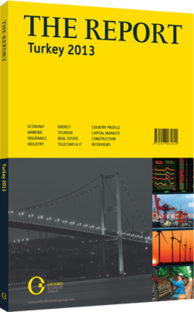OBG talks to Hakan Ates, CEO, Denizbank, and Süleyman Aslan, CEO, Halkbank

Interview: Hakan Ates, Süleyman Aslan
In what way did reduced economic growth in 2012 affect the balance sheets and the quality of assets held by domestic banks?
ATEŞ: First, prudent risk management has allowed local banks to keep non-performing loan (NPL) ratios at low levels. Although Turkey’s economic growth rate dropped markedly from 2011 to 2012, NPLs only rose from 2.7% to 3%. The system is extremely transparent, and regulation is very tight relative to Basel II or even Basel III requirements. Collateral quality for retail and corporate loan books is high compared to global standards. Actors in the economy, from bankers to regulators to producers, adopt cautious business strategies due to their past experiences of crises.
Second, due to low banking penetration and high loan demand, returns are high in Turkey compared to other countries. This means that risk appetite does not need to be excessive.
Third, corporate loan portfolios are highly diversified, and not concentrated in just one or two sectors of the economy. We vary portfolios through extensive retail lending, with credit bureaus and state-of-the-art scoring systems providing effective means of screening investment targets.
ASLAN: The growth slowdown in 2012, which was engineered by policymakers as part of a “soft landing” strategy, did not have an adverse impact on the banking system’s balance sheet structure. Though NPLs increased to 3% of total loans, this did not create any undue risks for the sector, which continues to be well capitalised. Indeed, Turkish banks have Tier 1 capital ratios that are well above BASEL II requirements; further, these ratios have shown no signs of deterioration over the last year.
Despite reduced economic expansion in 2012, and in spite of the suggested 15% ceiling on annual credit growth introduced by the central bank – a policy designed to reduce the current-account deficit – the banking industry produced extremely strong results for the year, including 16% loan portfolio growth.
In light of recent stresses, how resilient are Turkish banks to external macroeconomic shocks?
ASLAN: Turkish banks have proved resilient to the financial crisis in Europe. Even in 2011, when capital ratios at eurozone banks were under intense scrutiny, our lenders did not experience liquidity management issues. Thanks to prudent measures enforced by the Banking Regulation and Supervision Agency of Turkey, our banking system has become the envy of many European countries. The authorities have taken a proactive approach to monitoring global developments, and have helped to maintain a sufficient capital base across the industry.
Moreover, Turkish banks do not carry excessive risks on their books. We are able to finance growth through external and domestic borrowing because of new sovereign investment-grade rating from Fitch. In addition, Turkish banks have also begun targeting opportunities in new markets – a trend that has occurred alongside the diversification of the country’s trade portfolio away from European countries and towards the MENA region. ATEŞ: The 2007-08 global financial crisis was a perfect stress test for Turkish banks. Turkey was one of only three OECD countries (along with Canada and Australia) that did not need to provide support to its banking system. The sector is resilient to external shocks because it does not carry a great amount toxic assets or hidden liabilities. Further, Turkish banks have a capital adequacy rate of 18%, two-thirds of which is free capital.
This capital strength is sustainable because it is rooted in profitability. Between 2005 and 2012 the average return on investment in the sector was 19%. Finally, the funding base is stable. Around 62% of liabilities are deposits (including repo), most of which are retail. Wholesale funding is limited to a 13% share of the total. All told, these factors have been important in insulating the Turkish banking system from the global liquidity crunch being experienced today.
What was the impetus for the marked increase in international bond issuances from Turkish banks in 2012, and what impact will this have?
ATEŞ: The loan-to-deposit ratio reached 102% in 2012, making Turkish banks reliant on wholesale foreign borrowing to achieve growth. Further, due to Turkey’s recent investment grade rating, the credibility of local banks among global investors – who are already attracted by the country’s high yields – has improved markedly. As a result, Turkish banks roared onto the international debt scene last year, raising $8bn in dollar-denominated bonds, triple the amount of 2011. Among emerging markets, only Russia and Brazil issued more bonds.
More importantly, local banks have begun issuing lira-denominated bonds overseas, which reflects the increased credibility Turkey’s currency has earned in international markets. As our banks generate more lira-denominated funding, they will help solve the “original sin” problem – a situation where the companies of a country cannot use local currency. This is problematic because if the borrowing country’s domestic currency depreciates, the loans will become more difficult to service.
ASLAN: The rise in international bond issuances from local banks signals a growing trust in the Turkish economy throughout world markets. Given the low interest rate environment globally, as well as excess global liquidity, Turkey is well positioned to attract further bank bond investors in the coming years. Even with Turkish banks offering tighter yields, overseas demand is not likely to diminish.
International bond issuances may play an important role in boosting low-cost domestic lending, although, they did not have an impact in 2012, due to suggested loan growth introduced by the authorities. More importantly, international bond issuances will help Turkish banks to diversify their sources of funding and to address the maturity mismatch. Traditionally, the average maturity of deposits in the Turkish banking system has hovered around 70-75 days, while mortgage loans have had maturities of three to four years. This has made it difficult for lenders to offer long-term financing.
How can low-interest lending to small and medium-sized enterprises (SMEs) be encouraged?
ASLAN: SMEs are the driving force of the Turkish economy, but they definitely need more capital to expand. That is why the government has launched several initiatives designed to provide such firms with low-interest credit facilities – especially in the eastern and south-eastern provinces. This support is part of the new investment incentive scheme called Yatırım Te şvik Paketi, which is geared towards promoting value-added industries and export businesses in all corners of the country.
Banks can support SMEs by leveraging their relationships with international financial institutions such as the World Bank, the French Development Agency and the European Development Bank. In addition, they can cooperate more with local chambers of commerce to provide exclusive borrowing terms and conditions to their members. Finally, banks can support small businesses by offering new products, such as covered bonds. ATEŞ: The problem is not encouraging more SME lending, but increasing the availability of low-interest loans. Consequently, it is not only banks that need to support SMEs, but also depositors and supranational actors, who can help make low-interest funding resources available.
As Turkish banks begin to secure more low-interest capital in the coming years, due to the investment grade rating among other factors, they will not hesitate to provide greater assistance to small businesses, which are the backbone of the country’s economy. Indeed, SMEs represent 99.9% of all enterprises in Turkey, along with 77% of employment and just over a quarter (26.5%) of capital investment.
You have reached the limit of premium articles you can view for free.
Choose from the options below to purchase print or digital editions of our Reports. You can also purchase a website subscription giving you unlimited access to all of our Reports online for 12 months.
If you have already purchased this Report or have a website subscription, please login to continue.

